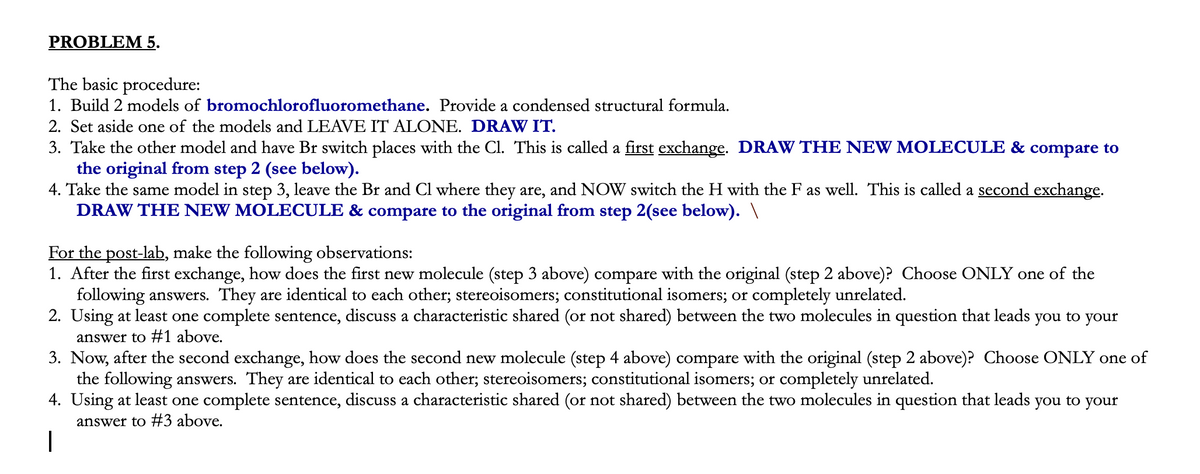PROBLEM 5. The basic procedure: 1. Build 2 models of bromochlorofluoromethane. Provide a condensed structural formula. 2. Set aside one of the models and LEAVE IT ALONE. DRAW IT. 3. Take the other model and have Br switch places with the Cl. This is called a first exchange. DRAW THE NEW MOLECULE & compare to the original from step 2 (see below). 4. Take the same model in step 3, leave the Br and Cl where they are, and NOW switch the H with the F as well. This is called a second exchange. DRAW THE NEW MOLECULE & compare to the original from step 2(see below). \ For the post-lab, make the following observations: 1. After the first exchange, how does the first new molecule (step 3 above) compare with the original (step 2 above)? Choose ONLY one of the following answers. They are identical to each other; stereoisomers; constitutional isomers; or completely unrelated. 2. Using at least one complete sentence, discuss a characteristic shared (or not shared) between the two molecules in question that leads you to your answer to #1 above. 3. Now, after the second exchange, how does the second new molecule (step 4 above) compare with the original (step 2 above)? Choose ONLY one of the following answers. They are identical to each other; stereoisomers; constitutional isomers; or completely unrelated. 4. Using at least one complete sentence, discuss a characteristic shared (or not shared) between the two molecules in question that leads you to your answer to #3 above.
Basics in Organic Reactions Mechanisms
In organic chemistry, the mechanism of an organic reaction is defined as a complete step-by-step explanation of how a reaction of organic compounds happens. A completely detailed mechanism would relate the first structure of the reactants with the last structure of the products and would represent changes in structure and energy all through the reaction step.
Heterolytic Bond Breaking
Heterolytic bond breaking is also known as heterolysis or heterolytic fission or ionic fission. It is defined as breaking of a covalent bond between two different atoms in which one atom gains both of the shared pair of electrons. The atom that gains both electrons is more electronegative than the other atom in covalent bond. The energy needed for heterolytic fission is called as heterolytic bond dissociation energy.
Polar Aprotic Solvent
Solvents that are chemically polar in nature and are not capable of hydrogen bonding (implying that a hydrogen atom directly linked with an electronegative atom is not found) are referred to as polar aprotic solvents. Some commonly used polar aprotic solvents are acetone, DMF, acetonitrile, DMSO, etc.
Oxygen Nucleophiles
Oxygen being an electron rich species with a lone pair electron, can act as a good nucleophile. Typically, oxygen nucleophiles can be found in these compounds- water, hydroxides and alcohols.
Carbon Nucleophiles
We are aware that carbon belongs to group IV and hence does not possess any lone pair of electrons. Implying that neutral carbon is not a nucleophile then how is carbon going to be nucleophilic? The answer to this is that when a carbon atom is attached to a metal (can be seen in the case of organometallic compounds), the metal atom develops a partial positive charge and carbon develops a partial negative charge, hence making carbon nucleophilic.

Carbon has a valency of four. This means that it can make bonds with four (same or different) atoms. Therefore, it is tetravalent.
If the four atoms or a group of atoms joined to the carbon atom via covalent linkage are different, the overall molecule is said to possess chirality.
Trending now
This is a popular solution!
Step by step
Solved in 4 steps with 6 images


